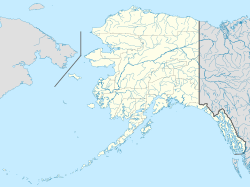Upper Kalskag, Alaska facts for kids
Quick facts for kids
Upper Kalskag, Alaska
|
|
|---|---|
| Country | United States |
| State | Alaska |
| Census Area | Bethel |
| Incorporated | February 13, 1975 |
| Area | |
| • Total | 4.00 sq mi (10.36 km2) |
| • Land | 3.56 sq mi (9.21 km2) |
| • Water | 0.45 sq mi (1.15 km2) |
| Elevation | 39 ft (12 m) |
| Population
(2020)
|
|
| • Total | 212 |
| • Density | 59.63/sq mi (23.02/km2) |
| Time zone | UTC-9 (Alaska (AKST)) |
| • Summer (DST) | UTC-8 (AKDT) |
| ZIP code |
99607
|
| Area code | 907 |
| FIPS code | 02-81320 |
| GNIS feature ID | 1404378 |
Upper Kalskag is a small city in Bethel Census Area, Alaska, United States. It is about 30 miles west of Aniak. In 2020, the city had a population of 212 people.
Contents
History and Culture
Upper Kalskag is a traditional Yup'ik village. The people living here have a culture that focuses on getting food and resources from nature. The first people who lived here came from a village called Kaltkhagamute. This village was located about four miles down the river.
Early Settlers and Influences
In 1843, a Russian explorer named Lavrenty Zagoskin reported that Kaltkhagamute had 120 people. Over time, people from other villages also moved to Upper Kalskag. These villages included Crow Village, Ohagamiut, Russian Mission, and Paimute.
Russian and American explorers brought new religions to the area. These included Roman Catholic and Russian Orthodox beliefs. In 1940, the Russian Orthodox followers moved away. They started a new village called Lower Kalskag, which is two miles downriver.
Community Development
In 1932, George Morgan, who was from Germany, opened a general store and a post office. He also founded Georgetown. Around 1930, Paul N. Kameroff Sr. also opened a general store, a pool hall, and a coffee shop. A government school was built around the same time. The community once had a large group of about 2,000 caribou.
Geography and Location
Upper Kalskag is located at coordinates 61.537440 degrees North and -160.316070 degrees West. The city covers a total area of about 4.1 square miles (10.6 square kilometers). Most of this area is land, about 3.8 square miles (9.8 square kilometers). The rest, about 0.3 square miles (0.8 square kilometers), is water.
Local Connections
Locals often call Upper Kalskag simply "Upper." It is connected to Lower Kalskag (which they call "Lower") by a two-mile gravel and dirt road. This road is kept in good condition.
Travel and Access
You can only reach Upper Kalskag by small plane or by boat. In the winter, you can also travel by car on the "ice road." This ice road is built every winter on the frozen river. It connects Aniak to Bethel. Workers drill holes in the ice every 100 yards to check its thickness. Then, they mark and clear a path where the ice is strong enough for vehicles.
Population and People
Upper Kalskag first appeared on the U.S. Census in 1940. It was mistakenly called "Old Kalskag" then. The population count was 70 people. The city was officially named Upper Kalskag when it became a city in 1975.
Population Changes Over Time
| Historical population | |||
|---|---|---|---|
| Census | Pop. | %± | |
| 1940 | 70 | — | |
| 1950 | 139 | 98.6% | |
| 1960 | 147 | 5.8% | |
| 1970 | 122 | −17.0% | |
| 1980 | 129 | 5.7% | |
| 1990 | 172 | 33.3% | |
| 2000 | 230 | 33.7% | |
| 2010 | 210 | −8.7% | |
| 2020 | 212 | 1.0% | |
| U.S. Decennial Census | |||
Demographics in 2000
In 2000, there were 230 people living in Upper Kalskag. There were 62 households and 44 families. The population density was about 60.8 people per square mile. Most of the people were Native American, making up 85.65% of the population. About 8.70% were White.
Many households (56.5%) had children under 18 living with them. The average household had 3.71 people. The average family had 4.55 people. The median age in the city was 22 years old. This means half the people were younger than 22 and half were older.
The median income for a household in the city was $28,333. For families, the median income was $32,708. About 24.2% of the population lived below the poverty line. This included 28.4% of those under 18.
See also
 In Spanish: Upper Kalskag para niños
In Spanish: Upper Kalskag para niños


